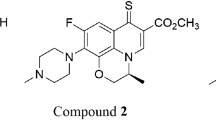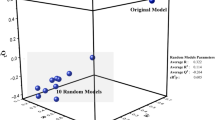Abstract
Hydroxamic acids [R(CO)N(OH)R’] are flexible compounds for organic and inorganic analyses due to their frailer structures compared to the carboxylic acid. The syntheses and characterization of benzohydroxamic acid (BHA), its CH3–, OCH3–, Cl– para-substituted derivatives and their Cr(III) complexes are reported herein. The metal complexes were synthesized by reacting the hydroxamic acids with chromium(III) chloride hexahydrate in 2:1 molar ratio. The compounds were characterized via melting point, elemental analysis, FTIR, 1H and 13C NMR, TGA, mass spectrometry, molar conductance and UV–Visible. Data analysis suggests that each complex has the Cr(III) center coordinated to the carbonyl and hydroxy oxygen atoms of the hydroxamic acids in bidentate O,O manner and two water molecules to form octahedral geometry. Non-electrolytic behavior of the complexes was shown through their low molar conductivity. Cytotoxicity study against HCT116 and alpha-glucosidase inhibition test revealed that all complexes have higher activity than their parent ligands. Molecular docking study shows that the docking of active complexes is thermodynamically favorable and the inhibition efficiency may depend on the types and the numbers of molecular interactions established in the corresponding stable conformers.








Similar content being viewed by others
References
Griffith D, Lyssenko K, Jensen P, Kruger PE, Marmion CJ (2005) Novel platinum(II) ammine hydroxamate and hydroximate complexes and the platinum-assisted hydrolysis of hydroxamic acids. Dalton Trans 5:956–961
Dixon NE, Hinds JA, Fihelly AK, Gazzola C, Winzor DJ, Blakeley RL, Zerner B (1980) Jack bean urease (EC 3.5.1.5). IV. The molecular size and the mechanism of inhibition by hydroxamic acids. Spectrophotometric titration of enzymes with reversible inhibitors. Can J Biochem 58:1323–1334
Wilkes SH, Prescott JM (1987) Hydroxamate-induced spectral perturbations of cobalt Aeromonas Aminopeptidase. J Biol Chem 262(18):8621–8625
Baker JO, Wilkes SH, Bayliss ME, Prescott JM (1983) Hydroxamates and aliphatic boronic acids: marker inhibitors for Aminopeptidase. Biochemistry 22(9):2098–2103
Sharma N, Kumari M, Kumar V, Chaudhry S, Kanwar S (2010) Synthesis, characterization, and antibacterial activity of vanadium(IV) complexes of hydroxamic acids. J Coord Chem 63:176–184
Griffith D, Bergamo A, Pin S, Vadori M, Muller-Bunz H, Sava G, Marmion CJ (2007) Novel platinum pyridinehydroxamic acid complexes: synthesis, characterisation, X-ray crystallographic study and nitric oxide related properties. Polyhedron 26:4697–4706
Marmion CJ, Murphy T, Docherty JR, Nolan KB (2000) Hydroxamic acids are nitric oxide donors. Facile formation of ruthenium(II)-nitrosyls and NO-mediated activation of guanylate cyclase by hydroxamic acids. ChemComm 13:1153–1154
Wang WH, Liu WS, Wang YW, Li Y, Zheng LF, Wang DQ (2007) Self-assembly and cytotoxicity study of waterwheel-like dinuclear metal complexes: The first metal complexes appended with multiple free hydroxamic acid groups. J Inorg Biochem 101(2):297–304
García B, Ibeas S, Leal JM, Secco F, Venturini M, Senent ML, Alfonso N, Muñoz C (2005) Conformations, protonation sites, and metal complexation of benzohydroxamic acid A theoretical and experimental study. Inorg Chem 44(8):2908–2919
Adiguzel E, Yilmaz F, Emirik M, Ozil M (2017) Synthesis and characterization of two new hydroxamic acids derivatives and their metal complexes. An investigation on the keto/enol, E/Z and hydroxamate/hydroximate forms. J Mol Struct 1127:403–412
Cefalu TW, Hu FB (2004) Role of chromium in human health and in diabetes. Diabetes Care 27(11):2741–2751
Vincent JB (2001) The bioinorganic chemistry of chromium(III). Polyhedron 20:1–26
Dong J, Liu B, Liang G, Yang B (2018) Synthesis, biological activity and toxicity of chromium(III) metformin complex as potential insulin-mimetic agent in C57BL/6 mice. J Coord Chem 71(10):1526–1541
Król E, Krejpcio Z, Okulicz M, Śmigielska H (2019) Chromium(III) glycinate complex supplementation improves the blood glucose level and attenuates the tissular copper to zinc ratio in rats with mild hyperglycaemia. Biol Trace Elem Res 193:185–194
Jacewicz D, Siedlecka-Kroplewska K, Pranczk J, Wyrzykowski D, Woźniak M, Chmurzyński L (2014) Cis-[Cr(C2O4)(pm)(OH2)2]+ coordination ion as a specific sensing ion for H2O2 detection in HT22 cells. Molecules 19(6):8533–8543
Rahman N, Muhammad I, Nayab GE, Khan H, Aschner M, Filosa R, Daglia M (2019) Molecular docking of isolated alkaloids for possible α-glucosidase inhibition. Biomolecules 9(10):1–17
Tagami T, Yamashita K, Okuyama M, Mori H, Yao M, Kimura A (2013) Molecular basis for the recognition of long-chain substrates by plant alpha-glucosidases. J Biol Chem 288:19296–19303
Hazalin NA, Ramasamy K, Lim SSM, Wahab IA, Cole AL, Majeed ABA (2009) Cytotoxic and antibacterial activities of endophytic fungi isolated from plants at the National Park, Pahang, Malaysia. BMC Complement Altern Med 9:1–5
Elya B, Basah K, Mun'im A, Yuliastuti W, Bangun A, Septiana EK, Iinuma M (2011) Screening of-glucosidase inhibitory activity from some plants of Apocynaceae, Clusiaceae, Euphorbiaceae, and Rubiaceae. J Biomed Biotechnol 2012:1–7
Morris GM, Huey R, Lindstrom W, Sanner MF, Belew RK, Goodsell DS, Olson AJ (2009) AutoDock4 and AutoDockTools4: automated docking with selective receptor flexibility. J Theor Comput 30:2785–2791
Shen X, Saburi W, Gai Z, Kato K, Ojima-Kato T, Yu J, Komoda K, Kido Y, Matsui H, Mori H (2015) Structural analysis of the α-glucosidase HaG provides new insights into substrate specificity and catalytic mechanism. Acta Crystallogr D 71:1382–1391
Al-Salahi R, Ahmad R, Anouar E, Iwana nor Azman N I, Marzouk M, Abuelizz H A, (2018) 3-Benzyl (phenethyl)-2-thioxobenzo [g] quinazolines as a new class of potent α-glucosidase inhibitors: synthesis and molecular docking study. Future Med Chem 10:1889–1905
Abuelizz HA, Dib RE, Marzouk M, Anouar E-H, Maklad AY, Attia NH, Al-Salahi R (2017) Molecular docking and anticonvulsant activity of newly synthesized quinazoline derivatives. Molecules 22:1094
Griffith D, Krot K, Comiskey J, Nolan KB, Marmion CJ (2008) Monohydroxamic acids and bridging dihydroxamic acids as chelators to ruthenium(III) and as nitric oxide donors: syntheses, speciation studies and nitric oxide releasing investigation. Dalton Trans 1:137–147
Obrien EC, Le Roy S, Levaillain J, Fitzgerald DJ, Nolan KB (1997) Metal complexes of salicylhydroxamic acid and O-acetylsalicylhydroxamic acid. Inorg Chim Acta 266:117–120
Farkas E, Enyedy EA, Micera G, Garribba E (2000) Coordination modes of hydroxamic acids in copper(II), nickel(II) and zinc(II) mixed-ligand complexes in aqueous solution. Polyhedron 19:1727–1736
Fazary AE (2014) Metal complexes of salicylhydroxamic acid and 1, 10-phen-anthroline; equilibrium and antimicrobial activity studies. Bull Chem Soc Ethiop 28:393–402
Shotor S, Kassim K, Bahron H, Tajuddin A, Yusof F, Marmion C, Rajab NF (2010) In-vitro cytotoxicity studies of vanadyl complexes with hydroxamic acid series, Science and Social Research (CSSR). In: 2010 international conference on, IEEE, pp 1283–1286
Abdualbasit G, Yang F, Emad Y, Mohamed K (2018) Synthesis and characterization of some diorganotin(iv) complexes of N-Tolyl- m-nitrobenzohydroxamic acid. J Eng Appl Sci 3:47–50
Haratake M, Fukunaga M, Ono M, Nakayama M (2005) Synthesis of vanadium (IV, V) hydroxamic acid complexes and in vivo assessment of their insulin-like activity. J Biol Inorg Chem 10:250–258
Deepak Sonu C, Krishna KV, Sapana G (2017) Synthesis, characterization and antimicrobial studies on some pyridoxylidenesulphamethoxazole schiff base tellurium (IV) complexes. Der Pharma Chem 9:59–64
Sharma R, Sharma N (2012) Thermal studies of some biologically active oxovanadium (IV) complexes containing 8-hydroxyquinolinate and hydroxamate ligands. J Therm Anal Calorim 110:539–543
Temel H, Şekerci M (2001) Novel complexes of manganese (III), cobalt (II), copper (II), and zinc (II) with schiff base derived from 1, 2-bis (p-amino-phenoxy) ethane and salicylaldehyde. Synth React Inorg Met 31:849–857
Bakar S N A, Bahron H, Kassim K, Synthesis and characterization of a novel Schiff base derived from 2, 4, 6-trimethyl-m-phenylenediamine with o-vanillin and its metal complexes, Science and Social Research (CSSR). In: 2010 international conference on, IEEE, 2010, pp 463–466.
Carrano CJ, Nunn CM, Quan R, Bonadies JA, Pecoraro VL (1990) Monomeric and dimeric vanadium(IV) and-(V) complexes of N-(hydroxyalkyl) salicylideneamines: structures, magnetochemistry and reactivity. Inorg Chem 29:944–951
Przychodzen W, Nycz JE, Nam Y-J, Lee D-U (2013) Cytotoxic and antioxidant activities of benzohydroxamic acid analogues. Notes 34:3099
Erdener Çıralı D, Uyar Z, Koyuncu İ, Hacıoğlu N (2015) Synthesis, characterization and catalytic, cytotoxic and antimicrobial activities of two novel cyclotriphosphazene-based multisite ligands and their Ru (II) complexes. Appl Organomet Chem 29:536–542
Refat MS, El-Korashy SA, Kumar DN, Ahmed AS (2008) Syntheses and characterization of Ru (III) with chelating containing ONNO donor quadridentate schiff bases. Spectrochim. Acta A 70:898–906
Indrianingsih AW, Tachibana S, Itoh K (2015) In vitro evaluation of antioxidant and α-Glucosidase inhibitory assay of several tropical and subtropical plants. Procedia Environ Sci 28:639–648
Funding
This work was funded by the Ministry of Higher Education of Malaysia for the research fund; 600-IRMI 5/3/GIP (004/2018), Universiti Teknologi MARA and AuRIns for research facilities and Faculty of Pharmacy for the facilities on cytotoxicity study.
Author information
Authors and Affiliations
Corresponding authors
Ethics declarations
Conflict of interest
The authors declare that they have no conflict of interest.
Additional information
Publisher's Note
Springer Nature remains neutral with regard to jurisdictional claims in published maps and institutional affiliations.
Rights and permissions
About this article
Cite this article
Hassan, L.R., Anouar, E.H., Bahron, H. et al. Cytotoxicity, alpha-glucosidase inhibition and molecular docking studies of hydroxamic acid chromium(III) complexes. J Biol Inorg Chem 25, 239–252 (2020). https://doi.org/10.1007/s00775-020-01755-6
Received:
Accepted:
Published:
Issue Date:
DOI: https://doi.org/10.1007/s00775-020-01755-6




